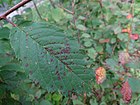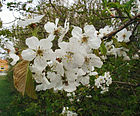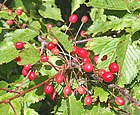Note: This is a project under development. The articles on this wiki are just being initiated and broadly incomplete. You can Help creating new pages.
Prunus avium - Elavālukaṃ
Elavālukaṃ consists of dried mature seed of Prunus avium Linn.f. (Fam. Rosaceae), a tree cultivated in Kashmir and lower Himalayas of Uttar Pradesh and W. Bengal seeds available in the market are enclosed in hard woody endocarp.
Uses
Cystitis, Oedema, Bronchial complaints, Anaemia, Cough, Indigestion, Respiratory problems, Looseness of the bowels.
Parts Used
Chemical Composition
It contains Prunasin (D-mandelonitrile-β-glucoside), Quercetin-3-0- rutinosyl-7, 3-0-biglucoside, Kaempferol-3-0-rutinosyl-4'-di-0-glucosideand 6-ethoxykaempferol.[1]
Common names
| Language | Common name |
|---|---|
| Kannada | |
| Hindi | Aaluvaalu, Gilaas, Krusabala |
| Malayalam | |
| Tamil | |
| Telugu | Jeevakamu |
| Marathi | NA |
| Gujarathi | NA |
| Punjabi | NA |
| Kashmiri | NA |
| Sanskrit | Aileyaḥ, Elavālūḥ, Elukākhyaḥ |
| English | Sweet Cherry |
Properties
Reference: Dravya - Substance, Rasa - Taste, Guna - Qualities, Veerya - Potency, Vipaka - Post-digesion effect, Karma - Pharmacological activity, Prabhava - Therepeutics.
Dravya
Rasa
Kaṣāya
Guna
Rūkṣa, Laghu
Veerya
Śīta
Vipaka
Kaṭu
Karma
Kaphahara, Yonidoṣahara, Varṇya, Stambhana, śukraśodhaka, Vedanāsthāpana, Viḍaghna
Prabhava
Habit
Identification
Leaf
| Kind | Shape | Feature |
|---|---|---|
| Oval | Oblong | Green and toothed with pointed tips, measuring 6–15cm with two red glands on the stalk at the leaf base. They fade to orange and deep crimson in autumn |
Flower
| Type | Size | Color and composition | Stamen | More information |
|---|---|---|---|---|
| Hermaphrodite | 8-15mm across | White | meaning the male and female reproductive parts are found in the same flower, in April. Flowers are White and cup-shaped with five petals, and measure 8-15mm across. They hang in clusters of 2-6. |
Fruit
| Type | Size | Mass | Appearance | Seeds | More information |
|---|---|---|---|---|---|
| oblong pod | Thinly septate, pilose, wrinkled | After pollination by insects, the flowers develop into globular, hairless deep red cherries | seeds upto 5 | Fruiting throughout the year |
Other features
List of Ayurvedic medicine in which the herb is used
- Aśvagandhā Taila
Where to get the saplings
Mode of Propagation
How to plant/cultivate
Better soils in hedgerows and woods, especially in beech woods. [3]
Commonly seen growing in areas
Photo Gallery
- Typisch silber-graue Borke der Vogel-Kirsche (Prunus avium) mit rot-braunen Lentizellen-hms(1).
Bark
References
- ↑ The Ayuredic Pharmacopoeia of India Part-1, Volume-5, Page no-57
- ↑ "Morphology"
- ↑ "Cultivation detail"
External Links
- Pages with broken file links
- Ayurvedic Herbs known to be helpful to treat Cystitis
- Ayurvedic Herbs known to be helpful to treat Oedema
- Ayurvedic Herbs known to be helpful to treat Bronchial complaints
- Ayurvedic Herbs known to be helpful to treat Anaemia
- Ayurvedic Herbs known to be helpful to treat Cough
- Ayurvedic Herbs known to be helpful to treat Indigestion
- Ayurvedic Herbs known to be helpful to treat Respiratory problems
- Ayurvedic Herbs known to be helpful to treat Looseness of the bowels
- Herbs with Fruits used in medicine
- Herbs with common name in Hindi
- Herbs with common name in Telugu
- Herbs with common name in Sanskrit
- Herbs with common name in English
- Habit - Herb
- Index of Plants which can be propagated by Seeds
- Index of Plants which can be propagated by Cuttings
- Herbs that are commonly seen in the region of Better soils in hedgerows
- Herbs that are commonly seen in the region of Specially in beech areas
- Herbs
- Ayurvedic herbs that don't have seed photos
- Rosaceae





